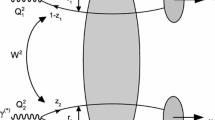Summary
The μ-e-γ vertex is calculated in the intermediate charged vector boson theory, as a function of the square of the four momentum of the photon. Consistency arguments show that the boson anomalous magnetic moment should be taken equal to zero. The result is then specialized to a real photon. The experimental branching ratio
fixes the cut-off value at less than one fifth the intermediate boson mass. It is concluded that this theory does not reasonably account for the experimental data, no matter how massive the boson is assumed to be.
Riassunto
Nella teoria del bosone vettoriale di carica intermedia, si calcola il vertice μ-e-γ come funzione del quadrato del tetraimpulso del fotone. Coerenti argomentazioni dimostrano che il momento magnetico anomalo del bosone dovrebbe essere assunto uguale a zero. Tale risultato è particolarizzato al caso di un fotone reale. Il rapporto sperimentale di « branching »
fissa il valore del taglio a meno di un quinto della massa del bosone intermedio. Si conclude che questa teoria non tiene conto in modo ragionevole dei dati sperimentali, comunque compatto si consideri il bosone.
Similar content being viewed by others
References
R. P. Feynman andM. Gell-Mann:Phys. Rev.,109, 193 (1958).
R. P. Feynman andM. Gell-Mann: 1958Annual International Conference on High Energy Physics at CERN.
G. Feinberg:Phys. Rev.,110, 1482 (1958).
M. E. Ebel andF. J. Ernst: to be published. These authors find a larger branching ratio than that obtained byFeinberg. The present authors also find the larger value.
J. Ashkin, T. Fazzini, G. Fidecaro, N. H. Lipman, A. W. Merrison andH. Paul:Nuovo Cimento,14, 1266 (1959).
A general phenomenological treatment of this process has been given recently byS. Weinberg andG. Feinberg:Phys. Rev. Lett.,3, 111 (1959), and byN. Cabibbo andR. Gatto, to be published. Our results obtained with the intermediate charged vector boson theory will be reported in a subsequent paper.
A similar situation occurs in the closely related process, the scattering of vector bosons by a Coulomb field. Ifλ ≠ 0 one obtains a physically unreasonable cross-section which increases indefinitely as the square of the boson energy. SeeW. Pauli:Rev. Mod. Phys.,13, 203 (1941), Table I.
As for example inS. S. Schweber, H. A. Bethe andF. de Hoffman:Mesons and Fields, Vol. I (Evanston, Ill., 1955). The notationq=q μγμ is used.
J. Schwinger:Ann. Phys.,2, 407 (1957).
Author information
Authors and Affiliations
Rights and permissions
About this article
Cite this article
Meyer, P., Salzman, G. The μ → e+γ decay and the intermediate charged vector boson theory. Nuovo Cim 14, 1310–1321 (1959). https://doi.org/10.1007/BF02962352
Received:
Published:
Issue Date:
DOI: https://doi.org/10.1007/BF02962352



